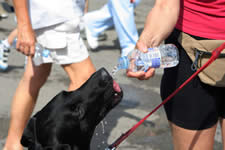Canine Bladder Infection
Symptoms, Causes, Treatment and Prevention
“Develop a good relationship with your veterinarian and
take your dog for regular checkups. A good vet contributes to a healthy pet.”
According to statistics, canine bladder infection, commonly known as Urinary Tract Infection (UTI), affects nearly 15 percent of the dog population worldwide. Not many dog owners are properly educated about this dog disease and are thus not able to get timely help for their beloved pets.
Overview/Snapshot of Disease or Condition
Canine bladder infection occurs when the bladder is infected with bacteria. However, UTI does not just involve the bladder; it might also involve the kidney and urethra.
Your dog’s urinary system consists of kidneys, a bladder, urethra and ureters. The main function of the urinary system is to filter wastes from the blood and eliminate them from the body.
There are certain canine health problems, diseases and conditions, such as kidney failure, bladder cancer, bladder stones, and canine diabetes mellitus that increase the risk that your dog may develop UTI. Female dogs are more prone to developing UTI than male dogs.
Symptoms
 The serious nature of canine bladder infection is an important reason to become familiar with its symptoms, including:
The serious nature of canine bladder infection is an important reason to become familiar with its symptoms, including:
- Increased urination
- Cloudy foul smelling urine
- Blood in urine
- Dark urine
- Your dog is constantly licking its genitals
- Tenderness in the lower abdominal area
- Pain while urinating
- Urinating small amounts frequently
- More incidences of accidents
These are some of the common symptoms associated with canine bladder infection. However, these symptoms are also associated with bladder stones, prostatitis and bladder cancer. So if you notice these symptoms in your dog, it is best to consult with your veterinarian as soon as possible.
Causes
In a normal, healthy dog there are no bacteria present in the bladder. Urinary tract infection occurs when bacteria enter the bladder through unclean food and water. The bacteria then travel through the blood and lymphatic system and make their way into the bladder.
Many experts believe that contaminated commercial dog food is responsible for UTI in dogs and cats, as well as other dog health problems.
Treatment
Treatment for canine bladder infection will start only after the diagnosis is made by a veterinarian. Your vet will take a urine sample to check for culture and sensitivity with the help of a urinalysis.
The culture and sensitivity test pinpoints the type of bacteria that is causing the infection. Based on this test, your vet will prescribe appropriate antibiotics. It is important to complete the entire dose of medicine to get rid of the infection, although many dog owners stop midway through treatment when they see improvement in their dog. Doing so only leads to recurrence of the UTI, so it is very important to complete the entire course of antibiotics.
If you see that even after completing the whole course of antibiotics your dog suffers a relapse, it will be important to have your dog checked for other dog diseases like bladder stones, cancer and diabetes mellitus.
Prevention
Feeding clean food and water to your dog is a must if you want to prevent canine bladder infection, as well as other canine health problems. Some would even advocate for avoiding dry commercial dog food, although that practice is debatable, depending on what you are feeding.
When urine stays in the bladder for long, it can cause infection. Accordingly, you should give your dog plenty of water to help keep the bladder clean and free of bacteria (that goes for humans, too!). Then take your dog out frequently and allow it to empty its bladder.
It has also been suggested to give your dog orange juice, making your dog’s urine acidic in nature and helping to prevent the build-up of bacteria in the bladder. Most people have heard about humans being advised to drink cranberry juice when they have a urinary tract infection. This is the same concept for dogs.
Develop a good relationship with your veterinarian and take your dog for regular checkups. A good vet contributes to a healthy pet.
Return to Dog Diseases and Symptoms
Return from Canine Bladder Infection to Dog Health Problems
Return to Dogs and Dog Advice home page